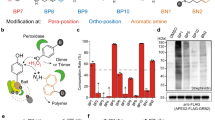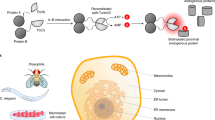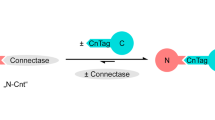Abstract
Fundamental to eukaryotic cell signaling is the regulation of protein function by directed localization. Detection of these events has been largely qualitative owing to the limitations of existing technologies. Here we describe a method for quantitatively assessing protein translocation using proximity-induced enzyme complementation. The complementation assay for protein translocation (CAPT) is derived from β-galactosidase and comprises one enzyme fragment, ω, which is localized to a particular subcellular region, and a small complementing peptide, α, which is fused to the protein of interest. The concentration of α in the immediate vicinity of ω correlates with the amount of enzyme activity obtained in a dose- and time-dependent manner, thus acting as a genetically encoded biosensor for local protein concentration. Using CAPT, inducible protein movement from the cytosol to the nucleus or plasma membrane was quantitatively monitored in multiwell format and in live mammalian cells by flow cytometry.
This is a preview of subscription content, access via your institution
Access options
Subscribe to this journal
Receive 12 print issues and online access
$259.00 per year
only $21.58 per issue
Buy this article
- Purchase on Springer Link
- Instant access to full article PDF
Prices may be subject to local taxes which are calculated during checkout




Similar content being viewed by others
References
Lever, J.E. The use of membrane vesicles in transport studies. CRC Crit. Rev. Biochem. 7, 187–246 (1980).
Tsien, R.Y. The green fluorescent protein. Annu. Rev. Biochem. 67, 509–544 (1998).
Balla, T. & Varnai, P. Visualizing cellular phosphoinositide pools with GFP-fused protein modules. Sci. STKE 125, 13 (2002).
Bronstein, I. & Kricka, L.J. Clinical applications of luminescent assays for enzymes and enzyme labels. J. Clin. Lab. Anal. 3, 316–322 (1989).
Lis, J.T., Simon, J.A. & Sutton, C.A. New heat shock puffs and β-galactosidase activity resulting from transformation of Drosophila with an hsp70-lacZ hybrid gene. Cell 35, 403–410 (1983).
Tung, C.H. et al. In vivo imaging of β-galactosidase activity using far red fluorescent switch. Cancer Res. 64, 1579–1583 (2004).
Ullmann, A., Jacob, F. & Monod, J. Characterization by in vitro complementation of a peptide corresponding to an operator-proximal segment of the β-galactosidase structural gene of Escherichia coli. J. Mol. Biol. 24, 339–343 (1967).
Moosmann, P. & Rusconi, S. α complementation of LacZ in mammalian cells. Nucleic Acids Res. 24, 1171–1172 (1996).
Mohler, W.A. & Blau, H.M. Gene expression and cell fusion analyzed by lacZ complementation in mammalian cells. Proc. Natl. Acad. Sci. USA 93, 12423–12427 (1996).
Zhao, X. et al. Homogeneous assays for cellular protein degradation using beta-galactosidase complementation: NF-κB/IκB pathway signaling. Assay Drug Dev. Technol. 1, 823–833 (2003).
Blakely, B.T. et al. Epidermal growth factor receptor dimerization monitored in live cells. Nat. Biotechnol. 18, 218–222 (2000).
Rossi, F.M. et al. Monitoring protein-protein interactions in live mammalian cells by beta- galactosidase complementation. Methods Enzymol. 328, 231–251 (2000).
Langley, K.E., Villarejo, M.R., Fowler, A.V., Zamenhof, P.J. & Zabin, I. Molecular basis of β-galactosidase α-complementation. Proc. Natl. Acad. Sci. USA 72, 1254–1257 (1975).
Langley, K.E., Fowler, A.V. & Zabin, I. Amino acid sequence of β-galactosidase. IV. Sequence of an alpha-complementing cyanogen bromide peptide, residues 3 to 92. J. Biol. Chem. 250, 2587–2592 (1975).
Kalderon, D. et al. A short amino acid sequence able to specify nuclear location. Cell 39, 499–509 (1984).
Ogawa, H. et al. Localization, trafficking, and temperature-dependence of the Aequorea green fluorescent protein in cultured vertebrate cells. Proc. Natl. Acad. Sci. USA 92, 11899–11903 (1995).
Juers, D.H. et al. High resolution refinement of β-galactosidase in a new crystal form reveals multiple metal-binding sites and provides a structural basis for α-complementation. Protein Sci. 9, 1685–1699 (2000).
Snoek, G.T. et al. The interaction of protein kinase C and other specific cytoplasmic proteins with phospholipid bilayers. Biochim. Biophys. Acta 860, 336–344 (1986).
Oancea, E. et al. Green fluorescent protein (GFP)-tagged cysteine-rich domains from protein kinase C as fluorescent indicators for diacylglycerol signaling in living cells. J. Cell Biol. 140, 485–498 (1998).
Franke, T.F. et al. The protein kinase encoded by the Akt proto-oncogene is a target of the PDGF-activated phosphatidylinositol 3-kinase. Cell 81, 727–736 (1995).
Marte, B.M. & Downward, J. PKB/Akt: connecting phosphoinositide 3-kinase to cell survival and beyond. Trends Biochem. Sci. 22, 355–358 (1997).
Gray, A., Van Der Kaay, J. & Downes, C.P. The pleckstrin homology domains of protein kinase B and GRP1 (general receptor for phosphoinositides-1) are sensitive and selective probes for the cellular detection of phosphatidylinositol 3,4-bisphosphate and/or phosphatidylinositol 3,4,5-trisphosphate in vivo. Biochem. J. 344, 929–936 (1999).
Haugh, J.M. et al. Spatial sensing in fibroblasts mediated by 3′ phosphoinositides. J. Cell Biol. 151, 1269–1280 (2000).
Kontos, C.D. et al. Tyrosine 1101 of Tie2 is the major site of association of p85 and is required for activation of phosphatidylinositol 3-kinase and Akt. Mol. Cell. Biol. 18, 4131–4140 (1998).
Fujii, M. et al. Real-time visualization of PH domain-dependent translocation of phospholipase C-Δ1 in renal epithelial cells (MDCK): response to hypo-osmotic stress. Biochem. Biophys. Res. Commun. 254, 284–291 (1999).
Van der Kaay, J. et al. Distinct phosphatidylinositol 3-kinase lipid products accumulate upon oxidative and osmotic stress and lead to different cellular responses. J. Biol. Chem. 274, 35963–35968 (1999).
Klarlund, J.K. et al. Signaling by phosphoinositide-3,4,5-trisphosphate through proteins containing pleckstrin and Sec7 homology domains. Science 275, 1927–1930 (1997).
Niswender, K.D. et al. Quantitative imaging of green fluorescent protein in cultured cells: comparison of microscopic techniques, use in fusion proteins and detection limits. J. Microsc. 180, 109–116 (1995).
Kandror, K.V. A long search for Glut4 activation. Sci. STKE 2003, PE5 (2003).
Necela, B.M. & Cidlowski, J.A. Development of a flow cytometric assay to study glucocorticoid receptor-mediated gene activation in living cells. Steroids 68, 341–350 (2003).
Schumacher, S.B. et al. Development of a dual luciferase reporter screening assay for the detection of synthetic glucocorticoids in animal tissues. Analyst 128, 1406–1412 (2003).
Zabin, I. β-Galactosidase α-complementation. A model of protein-protein interaction. Mol. Cell. Biochem. 49, 87–96 (1982).
Alauddin, M.M. et al. Receptor mediated uptake of a radiolabeled contrast agent sensitive to β-galactosidase activity. Nucl. Med. Biol. 30, 261–265 (2003).
Acknowledgements
We thank T. Meyer for the GFP-tagged AKT and C1A constructs, and A. Banfi for the MFG-IRES-CD8 vector. We also thank T. Byun, K. Marks and J. Jones for helpful discussion in design of the system. This work was supported by US National Institutes of Health grants AG09521, AG20961, HL65572, HD18179, Ellison Medical Foundation Grant AG-33-0817, and a grant from the Baxter Foundation to H.M.B.
Author information
Authors and Affiliations
Corresponding author
Ethics declarations
Competing interests
C.L.C. is now employed by KAI Pharmaceuticals.
Supplementary information
Supplementary Fig. 1
Dose response of PDGF assayed using the AKT PH domain CAPT system. (PDF 56 kb)
Supplementary Fig. 2
Limited effect of a peptide fusion on protein expression levels. (PDF 122 kb)
Rights and permissions
About this article
Cite this article
Wehrman, T., Casipit, C., Gewertz, N. et al. Enzymatic detection of protein translocation. Nat Methods 2, 521–527 (2005). https://doi.org/10.1038/nmeth771
Received:
Accepted:
Published:
Issue Date:
DOI: https://doi.org/10.1038/nmeth771
This article is cited by
-
Translocation of signalling proteins to the plasma membrane revealed by a new bioluminescent procedure
BMC Cell Biology (2011)
-
Selective killing of human immunodeficiency virus infected cells by non-nucleoside reverse transcriptase inhibitor-induced activation of HIV protease
Retrovirology (2010)
-
Molecular Imaging of Phosphorylation Events for Drug Development
Molecular Imaging and Biology (2009)
-
High-throughput screening assays for the identification of chemical probes
Nature Chemical Biology (2007)
-
A convenient, high-throughput assay for measuring the relative cell permeability of synthetic compounds
Nature Protocols (2007)



